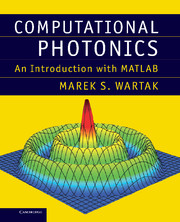Book contents
- Frontmatter
- Contents
- Preface
- 1 Introduction
- 2 Basic facts about optics
- 3 Basic facts from electromagnetism
- 4 Slab waveguides
- 5 Linear optical fibre and signal degradation
- 6 Propagation of linear pulses
- 7 Optical sources
- 8 Optical amplifiers and EDFA
- 9 Semiconductor optical amplifiers (SOA)
- 10 Optical receivers
- 11 Finite difference time domain (FDTD) formulation
- 12 Beam propagation method (BPM)
- 13 Some wavelength division multiplexing (WDM) devices
- 14 Optical link
- 15 Optical solitons
- 16 Solar cells
- 17 Metamaterials
- Appendix A Basic MATLAB
- Appendix B Summary of basic numerical methods
- Index
9 - Semiconductor optical amplifiers (SOA)
Published online by Cambridge University Press: 05 July 2013
- Frontmatter
- Contents
- Preface
- 1 Introduction
- 2 Basic facts about optics
- 3 Basic facts from electromagnetism
- 4 Slab waveguides
- 5 Linear optical fibre and signal degradation
- 6 Propagation of linear pulses
- 7 Optical sources
- 8 Optical amplifiers and EDFA
- 9 Semiconductor optical amplifiers (SOA)
- 10 Optical receivers
- 11 Finite difference time domain (FDTD) formulation
- 12 Beam propagation method (BPM)
- 13 Some wavelength division multiplexing (WDM) devices
- 14 Optical link
- 15 Optical solitons
- 16 Solar cells
- 17 Metamaterials
- Appendix A Basic MATLAB
- Appendix B Summary of basic numerical methods
- Index
Summary
The field of semiconductor optical amplifiers (SOA) is one of the fast growing in recent years. Many new applications of SOA were proposed. For comprehensive summaries, see books by Connolly [1] and Dutta and Wang [2].
In this chapter we will discuss the following topics:
• general concepts
• amplifier equations
• influence of cavity (FP amplifiers)
• gain dependence on polarization and temperature
• some applications.
Typical use of SOA in an amplifier configuration is shown in Fig. 9.1. Here, a signal from transmission fibre is imputed on SOA where it is amplified. After amplification it is redirected again to the fibre. Coupling between fibre and SOA is provided by an appropriate optical element.
General discussion
SOA is very similar to a semiconductor laser. There are two categories of SOA (see Fig. 9.2): (a) Fabry-Perot (FP) amplifier and (b) travelling-wave amplifier (TWA). The FP amplifier displays high gain but has a non-uniform gain spectrum, whereas TWA has broadband gain but requires very low facet reflectivities. The FP amplifier has large reflectivities at both ends which results in resonant amplification, and also has large gain at the wavelength corresponding to longitudinal modes of the FP cavity.
TWA has very small reflectivities, achieved by AR (anti-reflection) coating; its gain spectrum is broad but small ripples exist in gain spectrum, resulting from residual facet reflectivity. It is more suitable for system applications but the gain must be polarization independent.
- Type
- Chapter
- Information
- Computational PhotonicsAn Introduction with MATLAB, pp. 223 - 239Publisher: Cambridge University PressPrint publication year: 2013



